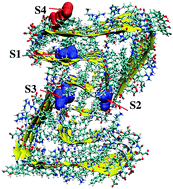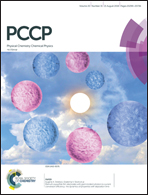Unusual binding-site-specific photophysical properties of a benzothiazole-based optical probe in amyloid beta fibrils†
Abstract
Optical imaging of amyloid fibrils serves as a cost-effective route for the diagnosis of Alzheimer-like conformational diseases. However, the challenge here is to optimize the binding affinity and photophysical properties of the optical imaging agents in a way specific to certain types of amyloids. In a few occasions it is shown that novel optical imaging agents can be designed to bind to a particular type of amyloid fibril with larger binding affinity and specificity. There is also a recent report on photoluminescent polythiophenes which display photophysical properties that can be used to distinguish the variants or subtypes of amyloids (J. Rasmussen et al., Proc. Natl. Acad. Sci. U. S. A., 2017, 114(49), 13018–13023). Based on a multiscale modeling approach, here, we report on the complementary aspect that the photophysical properties of a benzothiazole based optical probe (referred to as BTA-3) can be specific to the binding sites in the same amyloid fibrils and we attribute this to its varying electronic structure in different sites. As reported experimentally from competitive binding assay studies for many amyloid staining molecules and tracers, we also show multiple binding sites in amyloid fibrils for this probe. In particular, BTA-3 displayed a red-shift in its low-frequency absorption band only in site-4, a surface site of amyloid fibrils when compared to the spectra in water solvent. In the remaining sites, it exhibited a less significant blue shift for the same absorption band.



 Please wait while we load your content...
Please wait while we load your content...